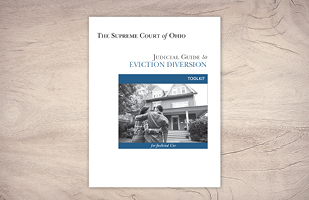New Resource Advises Judges How to Help Avert Evictions

The Supreme Court's new resource advises judges on strategies to assist both landlords and tenants.

The Supreme Court's new resource advises judges on strategies to assist both landlords and tenants.
A new resource guide to help municipal and county courts connect tenants and landlords to federal emergency rental-assistance funds was released by the Ohio Supreme Court today.
The Judicial Guide to Eviction Diversion outlines the role courts can play in helping to avoid housing evictions. It also explains strategies to divert landlord-tenant disputes.
Along with tactics on how to collaborate with community resource agencies to publicize available help and work with parties involved in housing disputes, the toolkit provides sample court forms and letters for judges and case parties.
Chief Justice Maureen O’Connor emphasized courts’ responsibilities to help avoid housing evictions during her State of the Judiciary address to hundreds of Ohio judges early this month.
“Now, more than ever, courts need to be proactive to divert tenants and landlords away from formal court action and instead seek rental assistance or alternative forms of dispute resolution,” Chief Justice O’Connor said. “Early interventions in eviction cases are the keys to preserving tenancy.”
Critical to the eviction-diversion effort is the federal government’s distribution of rental-assistance funds available to both tenants and landlords.
Relief dollars were distributed to states earlier in the COVID-19 public-health emergency and transferred to local community action agencies to provide direct assistance to individuals. The federal money can be used for rent and utility payments and for prospective rent, relocation services, and temporary hotel accommodations.
“The best practice is for courts to divert litigants from potential eviction and instead redirect tenants and landlords to emergency rental assistance,” said Stephanie Nelson, director of the Supreme Court’s Office of Court Services.
Courts can accomplish this, she said, through a court diversion program or the use of mediation, as well as utilizing housing “navigators” who are counselors to connect parties to available resources. “Parties need to know that relief is available, and they need time to apply for and receive those funds in a timely manner,” Nelson said.
The Supreme Court’s new toolkit advises how Ohio courts can help on both fronts by getting information to parties before an eviction action is filed and then allowing time for the rental-assistance process to occur.
“The sooner tenants and landlords become aware that relief funds are available, the higher the likelihood that a formal action will not be filed,” Nelson said.
Ohioans can receive assistance with rent, mortgage, or utilities from the state of Ohio, through their local community action agency. A list of local agencies is available online.
With the number of eviction cases expected to rise with the recent end to the Centers for Disease Control & Prevention’s (CDC) moratorium on evictions, this resource outlines strategies courts can use to prevent a backlog of cases.
“Courts are encouraged to familiarize themselves with the rental-assistance eligibility criteria and work with community agencies to better understand the U.S. Department of Treasury's latest guidance so that they can help to remove barriers, where possible, to facilitate the timely administration of justice,” Chief Justice O’Connor said to the state’s judiciary.
“The strategies identified in this toolkit will help prevent a potential surge of eviction cases, as well as effectively manage a case backlog.”


